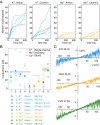Nonselective cation permeation in an AMPA-type glutamate receptor
- PMID: 33602810
- PMCID: PMC7923540
- DOI: 10.1073/pnas.2012843118
Nonselective cation permeation in an AMPA-type glutamate receptor
Abstract
Fast excitatory synaptic transmission in the central nervous system relies on the AMPA-type glutamate receptor (AMPAR). This receptor incorporates a nonselective cation channel, which is opened by the binding of glutamate. Although the open pore structure has recently became available from cryo-electron microscopy (Cryo-EM), the molecular mechanisms governing cation permeability in AMPA receptors are not understood. Here, we combined microsecond molecular dynamic (MD) simulations on a putative open-state structure of GluA2 with electrophysiology on cloned channels to elucidate ion permeation mechanisms. Na+, K+, and Cs+ permeated at physiological rates, consistent with a structure that represents a true open state. A single major ion binding site for Na+ and K+ in the pore represents the simplest selectivity filter (SF) structure for any tetrameric cation channel of known structure. The minimal SF comprised only Q586 and Q587, and other residues on the cytoplasmic side formed a water-filled cavity with a cone shape that lacked major interactions with ions. We observed that Cl- readily enters the upper pore, explaining anion permeation in the RNA-edited (Q586R) form of GluA2. A permissive architecture of the SF accommodated different alkali metals in distinct solvation states to allow rapid, nonselective cation permeation and copermeation by water. Simulations suggested Cs+ uses two equally populated ion binding sites in the filter, and we confirmed with electrophysiology of GluA2 that Cs+ is slightly more permeant than Na+, consistent with serial binding sites preferentially driving selectivity.
Keywords: electrophysiology; ion channel; molecular dynamics; neurotransmitter.
Copyright © 2021 the Author(s). Published by PNAS.
Conflict of interest statement
The authors declare no competing interest.
Figures






Similar articles
-
Asymmetry and Ion Selectivity Properties of Bacterial Channel NaK Mutants Derived from Ionotropic Glutamate Receptors.J Mol Biol. 2023 Mar 15;435(6):167970. doi: 10.1016/j.jmb.2023.167970. Epub 2023 Jan 20. J Mol Biol. 2023. PMID: 36682679
-
Selective exclusion and selective binding both contribute to ion selectivity in KcsA, a model potassium channel.J Biol Chem. 2017 Sep 15;292(37):15552-15560. doi: 10.1074/jbc.M117.795807. Epub 2017 Aug 4. J Biol Chem. 2017. PMID: 28778926 Free PMC article.
-
Selectivity filter modalities and rapid inactivation of the hERG1 channel.Proc Natl Acad Sci U S A. 2020 Feb 11;117(6):2795-2804. doi: 10.1073/pnas.1909196117. Epub 2020 Jan 24. Proc Natl Acad Sci U S A. 2020. PMID: 31980532 Free PMC article.
-
Emerging issues of connexin channels: biophysics fills the gap.Q Rev Biophys. 2001 Aug;34(3):325-472. doi: 10.1017/s0033583501003705. Q Rev Biophys. 2001. PMID: 11838236 Review.
-
Genetic manipulation of key determinants of ion flow in glutamate receptor channels in the mouse.Brain Res. 2001 Jul 13;907(1-2):233-43. doi: 10.1016/s0006-8993(01)02445-3. Brain Res. 2001. PMID: 11430906 Review.
Cited by
-
A Model for Predicting Cation Selectivity and Permeability in AMPA and NMDA Receptors Based on Receptor Subunit Composition.Front Synaptic Neurosci. 2021 Nov 29;13:779759. doi: 10.3389/fnsyn.2021.779759. eCollection 2021. Front Synaptic Neurosci. 2021. PMID: 34912205 Free PMC article.
-
Atomistic mechanisms of calcium permeation modulated by Q/R editing and selectivity filter mutations in GluA2 AMPA receptors.Proc Natl Acad Sci U S A. 2025 Aug 19;122(33):e2425172122. doi: 10.1073/pnas.2425172122. Epub 2025 Aug 14. Proc Natl Acad Sci U S A. 2025. PMID: 40811461 Free PMC article.
-
Fluoride Transport and Inhibition Across CLC Transporters.Handb Exp Pharmacol. 2024;283:81-100. doi: 10.1007/164_2022_593. Handb Exp Pharmacol. 2024. PMID: 36042142
-
Hippocampal AMPA receptor assemblies and mechanism of allosteric inhibition.Nature. 2021 Jun;594(7863):448-453. doi: 10.1038/s41586-021-03540-0. Epub 2021 May 12. Nature. 2021. PMID: 33981040 Free PMC article.
-
Mechanisms underlying TARP modulation of the GluA1/2-γ8 AMPA receptor.Nat Commun. 2022 Feb 8;13(1):734. doi: 10.1038/s41467-022-28404-7. Nat Commun. 2022. PMID: 35136046 Free PMC article.
References
-
- Sommer B., Köhler M., Sprengel R., Seeburg P. H., RNA editing in brain controls a determinant of ion flow in glutamate-gated channels. Cell 67, 11–19 (1991). - PubMed
Publication types
MeSH terms
Substances
LinkOut - more resources
Full Text Sources
Other Literature Sources
Medical

